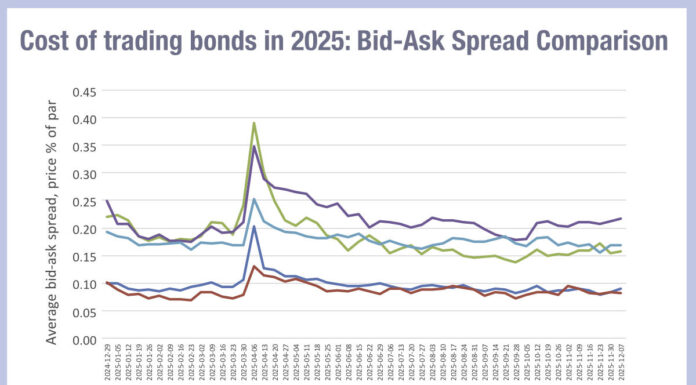Bringing the bond market’s loose ends together
Accurate bond pricing remains a challenge in today’s fixed income markets. Two critical issues stand in the way: data fragmentation and a lack of standardisation. Artificial intelligence (AI) offers a new approach by helping structure and interpret the vast, unstructured data traders rely on every day.
AI systems are optimal for data parsing and pattern recognition, including natural language recognition, because they are able to cater for variations that may occur around a known set of patterns or behaviours.
That is crucial in a market like fixed income where there are many areas of fragmentation, making it hard to pull information together into clear pictures. The heart of fragmentation in bond markets lies in the sheer number of securities that are issued by an entity, creating a complex map of securities to track and trade.

“If you look at equity markets, there are thousands of publicly-traded companies compared to many millions on the fixed income side,” notes Eugene Grinberg, co-CEO of SOLVE. “One of the challenges is there’s just not a ton of liquidity for the vast majority of fixed income instruments. If you look at any fixed income asset class, like corporates and munis, probably somewhere between 10-20% of it is actively trading, while the remaining 80% hasn’t got many buyers and sellers.”
Debt markets are commonly traded over-the-counter (OTC), meaning bilateral trading with some support from communication and trading platforms. This model lacks the centralization found in exchange-traded securities like equities or futures, where exchanges serve as the central hub for price and liquidity formation, connecting sell-side members to provide access to investors.
OTC markets require market makers to trade directly with their buy-side clients, taking on the risk of holding assets they will sell on, or have just bought. The multiplicity of securities from a single issuer can reduce the likelihood any given bond will be sought by clients, and market makers may end up holding more illiquid bonds.
The trading process creates further fragmentation, as deals need to be negotiated through an unstructured communication process – either via voice or chat tools – in the absence of execution via an electronic platform.
“The way traders communicate is largely by chat, by messages,” notes Grinberg. “So, a lot of the pricing is exchanged in these highly conversational, less structured ways. That leads to the data fragmentation and information asymmetries that we know are highly prevalent in fixed income assets.”
Together, the fragmented data sets that these elements create make both pre-and post-trade analysis of trading more difficult. Firms that are able to apply AI models to these data sets can potentially create meaningful insights from otherwise incredibly complex universes of information.
“Our focus over the last decade has been on helping market participants harness all the bids, offers and market colour that they’re seeing in these highly unstructured, conversational messages,” says Grinberg. “As a result, we built proprietary AI, machine learning, and natural language processing (NLP) tools to extract as much foundational data from messages as possible, to facilitate price discovery for the fixed income ecosystem.”
Having developed this set of technologies for aggregating communications information, the firm has evolved its offering in order to manage fragmentation across instruments and market structure.
“In the last couple of years, our focus has expanded to AI pricing, because 80% of corporates, munis, and other asset classes are not actively quoted,” Grinberg notes. “This is where AI shines. It is able to look at various features of bonds that do have quotes and trades, by seeing the world in hundreds of dimensions. We’re training our models on something like 300 different features, looking at the underlying bond characteristics. They look at quotes, they look at trades, and are able to price that 80% with a very high degree of accuracy.”
These tools can be used by traders, portfolio managers, quants, and algorithmic traders in a number of ways. Back-testing these models gives traders more confidence in the data. This information can then be used to support trading decisions, including which protocols to use, the level of high touch/low touch handling needed and how many brokers to bring in comp, or whether to reach out non-comp.
“They’re able to use it in the more traditional trading sense, in addition to feeding algorithms and automation, which is really the future of fixed income trading,” Grinberg says. “I’m extremely excited to announce that we just launched the Predictive Pricing Tool for the corporate bond markets. We collect Quotes data in munis, corporate bonds, securitised products, bank loans, and credit default swaps (CDS). Our plan is that, as we’ve done with munis, we will deliver the same predictive pricing across the gamut of corporate asset classes.”
©Markets Media Europe 2025














